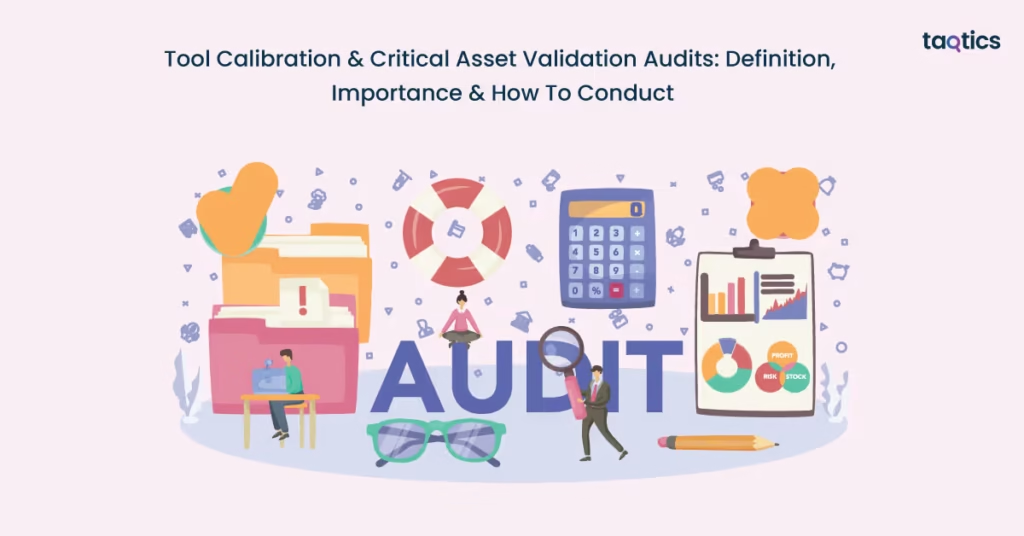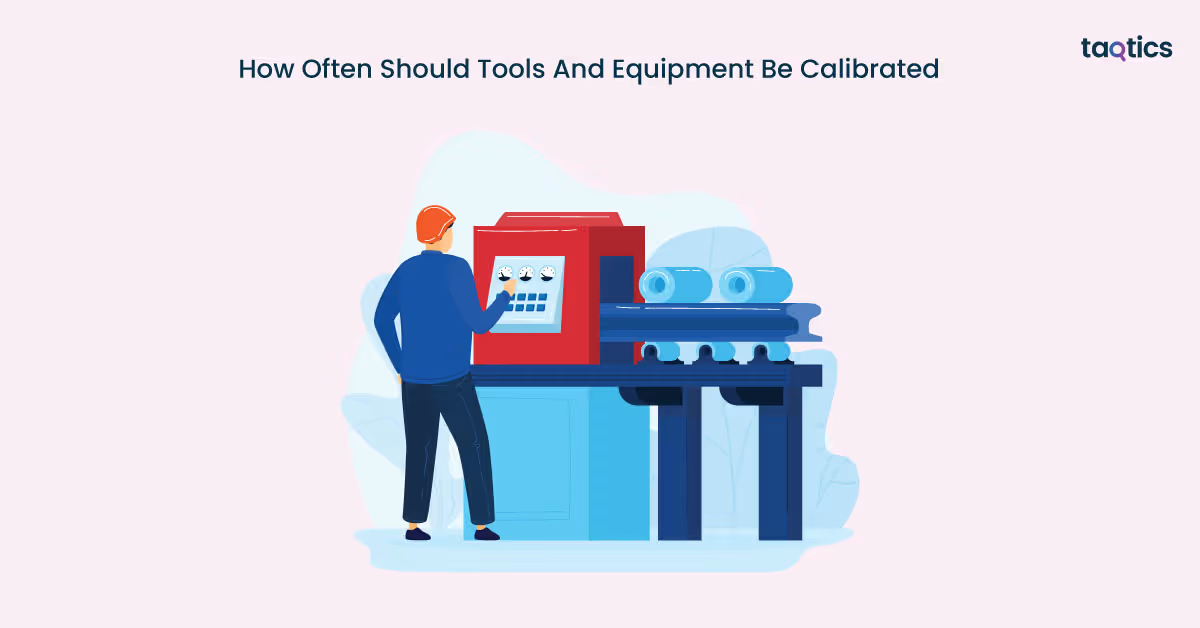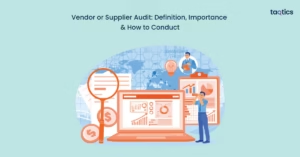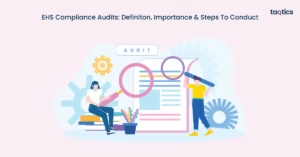Tool Calibration & Critical Asset Validation Audits: Definition, Importance & How To Conduct

Tool calibration and critical asset validation audits are systematic checks to ensure equipment and essential assets perform accurately and reliably. Tool calibration and critical asset validation audits help prevent operational errors by confirming that machines, tools, and measurement devices function within specified tolerances. Think of it like recalibrating a bathroom scale: if your scale is off by five pounds, you might misjudge your weight and make poor health decisions. The same principle applies in industries where even minor errors can lead to defective products, safety hazards, or regulatory issues.
The importance of these audits is underscored by their measurable impact on quality and safety. For example, the National Institute of Standards and Technology (NIST) reported in 2021 that calibration errors in manufacturing can cost U.S. industries billions annually in waste and rework. Similarly, the International Journal of Industrial Ergonomics (2022) found that effective calibration protocols can reduce equipment-related downtime by 25%. These numbers highlight that calibration and validation audits are not just about compliance; they are a cost-effective strategy to safeguard production quality and operational efficiency.
What Is A Tool Calibration & Critical Asset Validation Audit?
A tool calibration and critical asset validation audit is a structured assessment process that ensures measurement tools and essential assets meet defined performance standards. In metrology terms, tool calibration is the process of comparing measurement instruments against a standard of known accuracy to detect and correct deviations. Key principles include accuracy (the closeness of measurements to the true value), traceability (documented evidence that measurements align with national or international standards), and reproducibility (the ability of a tool to deliver consistent results over time and conditions). Uncalibrated tools create significant operational risks, often resulting in defective products, regulatory penalties, or costly recalls. For instance, a 2020 report by the U.S. Food and Drug Administration (FDA) found that over 20% of medical device recalls were tied to calibration and testing errors, illustrating how poor calibration practices can impact safety and compliance.
Critical assets are equipment or systems essential to operational safety, quality, or regulatory adherence. These include HVAC systems, autoclaves, pressure gauges, spectrometers, laboratory balances, and manufacturing robots. Organizations often adopt a risk-based classification approach to prioritize audits, focusing first on assets that pose the greatest impact if they fail. A study published in the Journal of Quality in Maintenance Engineering (2021) found that implementing risk-based asset management reduced unplanned equipment downtime by up to 30%. By combining calibration audits with asset validation, companies strengthen quality control, ensure regulatory compliance, and reduce operational vulnerabilities, making these audits a strategic investment rather than a procedural task.
What Is The Importance Of Tool Calibration & Critical Asset Validation Audit?
The importance of tool calibration and critical asset validation audit lies in its ability to ensure consistent quality, safety, and regulatory compliance across operations.
- Reduced Product Quality: Inaccurate or uncalibrated tools lead to variations in manufacturing, causing defects and higher rejection rates. A study by the American Society for Quality (ASQ, 2020) found that manufacturers lose an estimated 15% of their revenue annually due to poor quality, much of it linked to process inconsistencies.
- Increased Safety Risks: Equipment that is not validated or calibrated can malfunction, creating hazardous conditions. The U.S. Bureau of Labor Statistics reported over 2.6 million workplace injuries and illnesses in 2021, with equipment failures identified as a leading contributing factor.
- Higher Operational Costs: Frequent breakdowns and recalls drain resources. According to a 2022 PwC report, product recalls cost U.S. companies an average of $10 million per incident, excluding long-term brand damage and lost market share.
- Non-Compliance with Regulations: Regulatory bodies like ISO, FDA, and OSHA mandate calibration and validation to ensure public safety. The FDA issued 4,692 warning letters in 2021, many tied to quality system deficiencies, including calibration non-compliance.
- Loss of Customer Trust: Consistent failures and recalls erode brand reputation, making it difficult to retain customers. Deloitte’s 2021 consumer trust survey found that 81% of customers lose trust in a brand after just one bad product experience.
By prioritizing these audits, companies create a foundation for operational excellence and long-term growth.
What Are the Benefits of Tool Calibration & Critical Asset Validation Audit
The benefits of tool calibration and critical asset validation audit include improvement of accuracy, safety, and efficiency while protecting the businesses’ reputation and bottom line.
- Enhanced Measurement Accuracy: Regular calibration ensures tools deliver precise results, reducing variability. According to the National Conference of Standards Laboratories International (NCSLI, 2021), organizations that maintain strict calibration programs can reduce measurement uncertainty by up to 50%, directly improving quality control.
- Improved Quality and Consistency: Consistent product quality strengthens competitiveness. A study by McKinsey (2020) revealed that companies with robust quality management systems see up to a 40% improvement in production reliability, reinforcing calibration as a cornerstone of consistency.
- Reduced Downtime and Costs: Proactive maintenance through audits limits costly equipment failures. Research from Plant Engineering (2022) found that predictive maintenance programs can lower equipment downtime by 35% and maintenance costs by 30%, highlighting the financial value of calibration.
- Regulatory Compliance: Regular audits ensure adherence to strict standards like ISO 17025 or FDA regulations. Non-compliance penalties can be severe, with OSHA recording over $136 million in workplace safety penalties in 2021, underscoring the importance of staying compliant.
- Increased Efficiency and Productivity: Calibrated assets operate optimally, minimizing delays. A Deloitte study (2022) noted that companies investing in calibration and validation audits reported a 20% boost in operational efficiency, translating into faster output.
- Better Safety and Risk Management: Well-maintained equipment reduces hazards and liability risks. The International Labour Organization (ILO, 2021) reported that 3 million workers globally die annually from work-related accidents or diseases, showing the stakes of poor equipment oversight.
- Enhanced Reputation and Customer Satisfaction: Demonstrating a commitment to precision and safety strengthens customer trust. A PwC report (2021) found that 73% of consumers consider product quality their top purchasing factor, proving calibration’s role in brand loyalty.
These audits are essential for compliance and maximizing efficiency, reducing costs, and safeguarding reputation for long-term stability and growth.
How To Conduct A Tool Calibration & Critical Asset Validation Audit?
You can conduct a tool calibration and critical asset validation audit by following a structured, step-by-step process designed to ensure precision, compliance, and operational efficiency.
- Define Audit Objectives: Begin by clearly outlining why the audit is being performed, whether to evaluate maintenance effectiveness or meet regulatory requirements. According to ISO 19011 guidelines (2021), audits with clearly defined objectives are 30% more likely to achieve measurable improvements.
- Define Scope and Identify Assets: Determine which equipment or systems will be audited, prioritizing high-risk or production-critical assets. The Aberdeen Group (2020) reported that risk-based asset prioritization can cut equipment-related downtime by 20%, highlighting the importance of focusing on critical systems.
- Gather Documentation: Collect essential records like calibration certificates, maintenance logs, and operational data. A report by ARC Advisory Group (2022) revealed that organizations using centralized documentation systems reduce audit preparation time by up to 50%.
- Perform Physical Verification: Conduct on-site inspections to verify asset condition and accuracy. The Institute of Asset Management (IAM, 2021) found that field verification during audits reduces asset data discrepancies by 40%, improving decision-making.
- Analyze Maintenance Practices and Identify Gaps: Review maintenance programs to identify inefficiencies. A Plant Services survey (2022) indicated that companies conducting annual audits reported 25% fewer unexpected breakdowns due to early detection of gaps.
- Report Findings and Recommend Actions: Provide actionable recommendations based on the audit’s findings. The International Organization for Standardization (ISO, 2020) stresses that clear reporting is critical for implementing lasting improvements in asset management.
- Implement Corrective Actions: Address identified issues promptly to improve equipment performance. According to Reliabilityweb (2021), organizations that act on audit recommendations within three months experience up to 15% cost savings on maintenance.
- Leverage Technology: Use asset management software to streamline audits, automate data capture, and track calibration schedules. Gartner (2022) reported that digital asset management systems improve audit efficiency by 35% and reduce compliance risks significantly.
Adopting a systematic approach to calibration and asset validation audits, organizations can strengthen operational reliability, ensure regulatory compliance, and achieve long-term cost savings.
How Often Should Tools And Equipment Be Calibrated?
The tools and equipment should be calibrated based on usage, environmental conditions, manufacturer guidance, and risk assessments rather than fixed intervals.

- Factors Affecting Calibration Frequency:
- Tools used frequently or in critical processes need shorter calibration cycles.
- Harsh conditions, such as extreme temperatures, vibration, or humidity, can accelerate instrument wear.
- ISO 10012:2003 emphasizes that calibration intervals should be based on risk assessment, equipment performance, and operational context.
- A National Physical Laboratory study (2021) found accuracy degradation is 40% faster in extreme environments, showing why conditions matter.
- Interval Scheduling Best Practices:
- ISO/IEC 17025:2017 recommends reviewing calibration intervals using historical data and trends to ensure precision.
- Predictive and condition-based schedules prevent over-calibration while maintaining reliability.
- A 2020 Journal of Quality and Reliability Engineering report noted up to 25% reduction in unnecessary calibrations using data-driven scheduling.
- Aligning intervals with internal SOPs ensures consistent practices and prepares organizations for regulatory audits.
Calibration planning should be a dynamic process that adapts to tool performance, environmental factors, and regulatory needs.
Who is Responsible for Tool Calibration & Critical Asset Validation Audit?
The responsibility of tool calibration and critical asset validation audits is taken either by internal auditors or third-party auditors, depending on the organization’s size, resources, and regulatory requirements. Both approaches have distinct advantages, and many companies use a combination of the two to ensure comprehensive oversight.
Internal Vs. Third-Party Auditors
| Aspect | Internal Auditors | Third-Party Auditors |
| Role | Handle day-to-day calibration checks, maintenance audits, and internal SOP compliance. | Conduct independent evaluations, often required for certifications or regulatory approvals. |
| Expertise | Deep knowledge of internal processes and systems. | Specialized expertise, advanced tools, and industry certifications (e.g., ISO/IEC 17025). |
| Cost | Generally lower cost since staff are already on payroll. | Higher costs due to specialized services but can prevent expensive compliance failures. |
| Objectivity | May lack full objectivity due to being part of the organization. | Provides an unbiased, impartial assessment of calibration and validation processes. |
| Regulatory Alignment | Focused on internal quality standards like ISO 9001 and company SOPs. | Ensures compliance with external regulations such as FDA, OSHA, and ISO certifications. |
| Frequency | Ongoing, frequent checks for operational efficiency. | Periodic audits for certification renewal, regulatory compliance, and risk assessment. |
| Impact on Compliance Risk | Identifies internal issues early but may miss external standard nuances. | Deloitte (2022) found up to 30% fewer compliance penalties when third-party audits are performed. |
| Adoption Rate | IIA (2021) reported 67% of organizations rely primarily on internal teams for ongoing audits. | Widely used in high-risk industries like pharmaceuticals, aerospace, and healthcare for added assurance. |
Both internal and third-party auditors play essential roles in maintaining calibration accuracy and asset reliability. A hybrid approach, leveraging internal knowledge and external expertise, offers the strongest assurance of compliance, safety, and operational excellence.
What Should Be Included In A Calibration Certificate?
A calibration certificate should include clear, standardized details that verify the accuracy of measurements and prove compliance with industry standards. These documents act as formal evidence of traceability, ensuring tools and equipment meet required performance levels.
Unique ID
Each certificate should have a unique identification number to link it to a specific tool or instrument. ISO/IEC 17025:2017 highlights that traceable identifiers are critical to maintaining data integrity and audit readiness.
Calibration Date & Due Date
Including both the date of calibration and the next due date ensures proper scheduling. A Quality Magazine study (2021) found that equipment calibrated on time reduces production errors by up to 29%.
Environmental Conditions
Conditions such as temperature and humidity must be recorded, as they directly influence measurement accuracy. Research by the National Metrology Institute of Germany (PTB, 2020) showed environmental deviations can shift measurement results by 10–15%.
Measurement Uncertainty
Certificates must specify the uncertainty range to quantify confidence in the results. According to NCSLI (2021), clear uncertainty documentation improves compliance audit pass rates by 22%.
Pass/Fail Results
A summary of whether the instrument meets specified tolerances helps organizations make immediate decisions about usability.
Reference Standard Traceability
Traceable references linking results to national or international standards are essential. ISO 10012:2003 emphasizes traceability as a foundation for measurement reliability.
Technician Signature and Accreditation Info
A qualified technician’s signature and lab accreditation details provide proof of credibility. A study in the Journal of Calibration (2022) found that accredited calibration providers reduce dispute cases by 35%.
A well-structured calibration certificate is more than a formality; it is a legally recognized record that supports compliance, improves operational trust, and provides traceability for every measurement performed.
What Are Common Audit Findings And How Can You Avoid Them?
The common audit findings and the ways to avoid them shared below highlight key weaknesses that often emerge during tool calibration and critical asset validation audits, and the ways to address them to ensure compliance and prevent costly disruptions to operations.

Out-of-Tolerance Instruments
Instruments frequently fail audits when they no longer meet specified tolerances, leading to inaccurate measurements. A report by the National Institute of Standards and Technology (NIST, 2021) revealed that measurement inaccuracies contribute to up to $1.7 billion in annual manufacturing losses. To avoid this, organizations should implement preventive maintenance programs, perform routine checks, and use predictive analytics to catch early signs of drift.
Missing Calibration Records
Missing or incomplete documentation is a common finding that complicates regulatory audits. According to the Journal of Quality Assurance (2020), companies with centralized digital calibration record systems reduce documentation errors by 40%. Establishing an electronic record management system and linking calibration records to each asset’s unique ID ensures easy access and traceability.
Expired Calibration Dates
Instruments used past their calibration due date increase compliance risks and measurement errors. The International Organization for Standardization (ISO) emphasizes in ISO 9001:2015 that timely calibration scheduling is a core requirement for quality assurance systems. Automated reminders and asset management software can help avoid lapses and ensure timely recalibration.
Inadequate Traceability
Tools that cannot be traced to recognized standards weaken audit credibility. The European Federation of National Metrology Institutes (EURAMET, 2021) reported that traceability gaps account for 25% of failed equipment audits. Organizations should partner with accredited calibration labs and ensure certificates reference recognized national or international standards.
Recommendations
To prevent recurring audit findings, companies should adopt risk-based asset classification, invest in staff training, and integrate calibration tracking software. A Deloitte study (2022) found that companies implementing digital calibration management saw a 32% improvement in overall audit scores, reinforcing the value of technology-driven solutions.
Tackling these common audit findings with robust systems, preventive measures, and digital tools strengthens compliance, reduces costs, and ensures the reliability of critical tools and assets.
How Do You Prepare For A Third-Party Or Regulatory Audit?
You can prepare for a third-party or regulatory audit by planning a proactive, well-organized approach that ensures full compliance with industry standards and regulations.
- Understand Audit Scope and Requirements: Begin by reviewing the audit’s objectives, applicable standards (e.g., ISO 17025, ISO 9001), and regulatory expectations. A study by Compliance Week (2022) found that organizations that review audit requirements thoroughly are 40% more likely to pass without major findings.
- Conduct Internal Pre-Audits: Simulate the audit internally to identify gaps early. According to the Institute of Internal Auditors (IIA, 2021), companies that run mock audits reduce compliance issues by 25%. This step also familiarizes staff with the process.
- Ensure Complete Documentation: Verify that calibration certificates, maintenance logs, SOPs, and training records are accurate and accessible. Research by ARC Advisory Group (2022) shows digital documentation systems cut audit preparation time by 50%, reducing stress and errors.
- Organize Assets and Calibration Records: Ensure all instruments are labeled, calibrated, and traceable to recognized standards. Missing or outdated records are a leading cause of audit findings, so a centralized asset management system is vital.
- Train and Prepare Staff: Employees should understand their roles during the audit, including answering auditor questions. Deloitte (2021) reports that regular compliance training reduces non-conformance rates by 20%.
- Address Non-Conformances Early: Resolve known issues before the audit and document corrective actions. Auditors value transparency and proactive problem-solving, which can turn potential findings into evidence of a strong quality culture.
- Set Up a Clear Audit Plan: Create a detailed audit agenda that includes timelines, designated rooms or areas for auditor review, and point-of-contact staff. This organization improves auditor confidence and ensures a smoother process.
A combination of internal audits, staff training, robust documentation systems, and proactive issue resolution ensures smoother audits and stronger compliance outcomes.
What Is The Difference Between Calibration And Validation Of Equipment?
The difference between calibration and validation of equipment lies in their purpose, focus, and application within quality and compliance processes.
| Aspect | Calibration | Validation |
| Definition | The process of comparing measurement tools to a known standard and adjusting them to ensure accuracy. | The process of verifying that equipment consistently performs as intended and meets operational needs. |
| Goal | To ensure measurement accuracy and traceability to national/international standards. | To ensure fit-for-purpose functionality and compliance with regulatory or operational requirements. |
| Focus | Focuses on instrument precision and measurement errors. | Focuses on the overall performance of equipment or systems. |
| Frequency | Done regularly based on manufacturer recommendations, usage, and environmental conditions. | Performed periodically or after changes (installation, upgrades, or process modifications). |
| Documentation | Results in a calibration certificate detailing accuracy, uncertainty, and traceability. | Results in a validation report proving equipment meets intended use and regulatory standards. |
| Standards Referenced | ISO/IEC 17025, ISO 10012 | ISO 9001, Good Manufacturing Practices (GMP), FDA regulations. |
| When Required | Whenever precise measurements are needed. | For regulated industries (e.g., pharmaceuticals, aerospace) to ensure safe and consistent operations. |
Calibration ensures that equipment is accurate and traceable to standards, while validation ensures that it is fit for its intended purpose and compliant with regulations. Both processes work together to safeguard product quality, operational efficiency, and safety.



